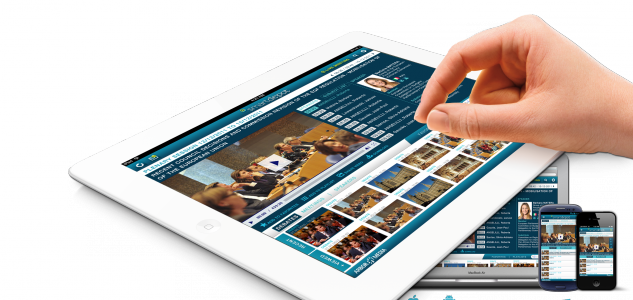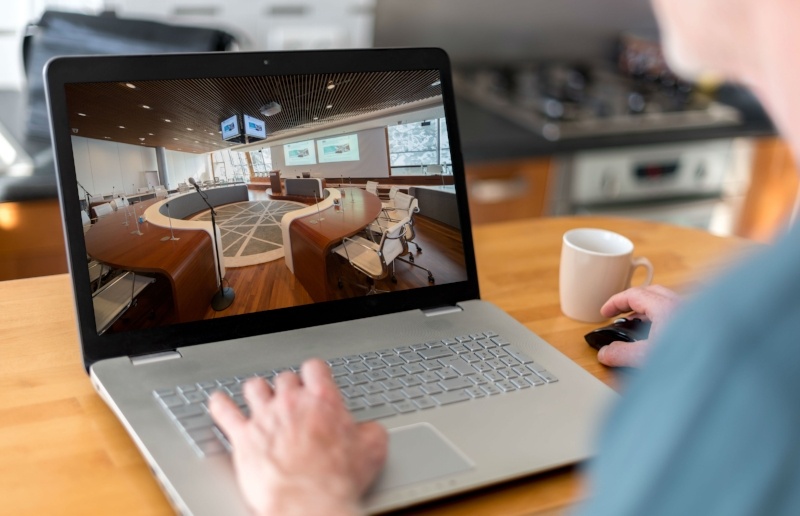News
The 8 most common mistakes when streaming meetings
12-07-2020 14:09We meet more and more clients who want to have their meetings and events, live or on-demand (VOD), via the internet (streaming). Clients who want to give colleagues, citizens, etc. the opportunity to virtually sit in a meeting room to hear and see what is being discussed. And not only that… also to ask questions, provide input and interact. But, how do you provide an infrastructure that makes this possible? What to pay attention to? What do you do? and –perhaps more importantly – what don’t you do? In this blog we will go into more depth on this …
Transparency as a basis
There may be different reasons why organisations choose to make (some) meetings and events “accessible” through the internet. The most important reason is transparency. It is precisely by being transparent about e.g. a decision-making process that connection with the target audience is ensured and commitment is encouraged. A clear signal is given that employees, citizens and/or other stakeholders are important for the organisation. Such a signal can mean great appreciation and sympathy.
A streaming solution that delivers what you expect
In order to actually achieve this transparency (and hence gain sympathy and appreciation), a reliable streaming & archiving solution must be implemented. Avoiding the mistakes listed below is a big step towards a solution that actually meets the expectations and contributes to your (business) goals.
1. Not a clear overview of own your own objectives
Transparency and sympathy are good reasons to consider webcasting (live and on-demand streaming of meetings and events). However, in order to be successful in using these solutions as well as to optimise their use, it is important to be clear from the beginning, when you want to use this modern technology and what you want to achieve. In doing so, “the more concrete, the better” applies here which leads to formulate your objectives as much as possible using the SMART criteria. Consider ratings, viewing time, evaluation, client satisfaction, NPS, growth in use, etc.
2. Insufficient overview, too little detail
Cameras are needed to capture meetings. Dome cameras are often used for this purpose; small, compact cameras that are discreetly integrated into an interior. In addition to the recording quality of the cameras (full HD is standard), it is particularly important that a sufficient number of cameras are installed in a room so that individual speakers can be viewed properly – and directly from the front. It is also important to install an overview camera, so that the images from the individual speakers can be alternated with shots of the entire room.
3. Poor sound reproduction, not taking advantage of digital possibilities
Good intelligibility is key. Everything can be taken care of to the last detail, but if the speakers cannot be understood, all effort is in vain. Therefore, you should opt for high-quality sound amplification. This can be done with (wireless) microphones or clip on microphones in combination with loudspeakers, but for larger groups, a digital discussion system (conferencing system) is advisable. The advantage of such a system is that it can be linked to the camera-tracking system which automatically displays speakers, including speaker information and other metadata.
4. Failure to use digital reporting
Modern systems can do much more than streaming video and audio over the internet, whether or not they are enriched with additional data (metadata). A very important functionality – which unfortunately is not always taken into account – is the possibility of digital reporting (logbook function), with which you store and index the recordings so that they can also be viewed at a later time and are easily searchable – e.g. by keyword -; video-on-demand (VOD). You create a powerful reference work. However, it is important that you ensure sufficient storage capacity and data security.

5. No use of interaction-tools
As mentioned in the introductory paragraph… transparency leads to commitment. A commitment that we, Dutch people, like to express by thinking along with you, by asking questions, by giving our opinion, etc. There are different streaming solutions available on the market, that allow you to show the (live) recordings of your meetings on a portal – in your own in-house style – that is provided with one or more tools to stimulate the interaction with your spectators on the virtual stand. For example, the possibility to ask questions through a chat function (Q&A to respond), through Twitter or to take live polls.
6. Not taking advantage of your corporate identity
What still happens too often is that there is too little or no attention to the last details. By this I mean that for maximum impact and participation in a live streamed meeting, everything must be perfect. The quality of the video and sound, and the possibility to respond and give feedback, but also the look and feel of the portal on which the video is displayed. Are you communicating what you want to communicate? Does the design match your corporate identity? If this is the case, viewers will value your meeting– but also your organisation – more positively.
7. Forgetting to take into account the increased number of viewers
It is advisable to bear in mind that the number of viewers will increase over time, especially if the increase in numbers is one of the objectives that have been formulated and you are actively oriented towards this goal. Therefore, it is particularly important that, when designing or realising your streaming solution, you pay attention to the scalability of the system; i.e. in terms of the required hardware, software clients, internet bandwidth etc. There is nothing more disappointing than a system that is dying out of its success, because insufficient thought was given beforehand to the required capacity.
8. Just having an eye for online reality
As important as it may seem, streaming images and sound via the internet is not the only way to present your meetings. Especially if the room in which a meeting is being held is a rather large one– such as in a boardroom or auditorium – it is a good idea to have image displayers installed in that room as well. The image that viewers see through the internet, can then also be seen in the conference room. And that is very pleasant for the participants in the meeting who are physically in the room. After all, they first and foremost have the right to see their meeting partners clearly.
Running a fully digital workflow
I have described 8 pitfalls when implementing a streaming solution to present your meetings and other events via the internet, so that colleagues and interested parties – anywhere in the world – can follow live and on-demand what is being discussed and decided. Avoiding these 8 pitfalls will bring you one big step closer to a system that really meets your expectations and contributes to the realisation of your goals. Also, a system that enables a fully digital and automated workflow. Find out more about our streaming solutions.

